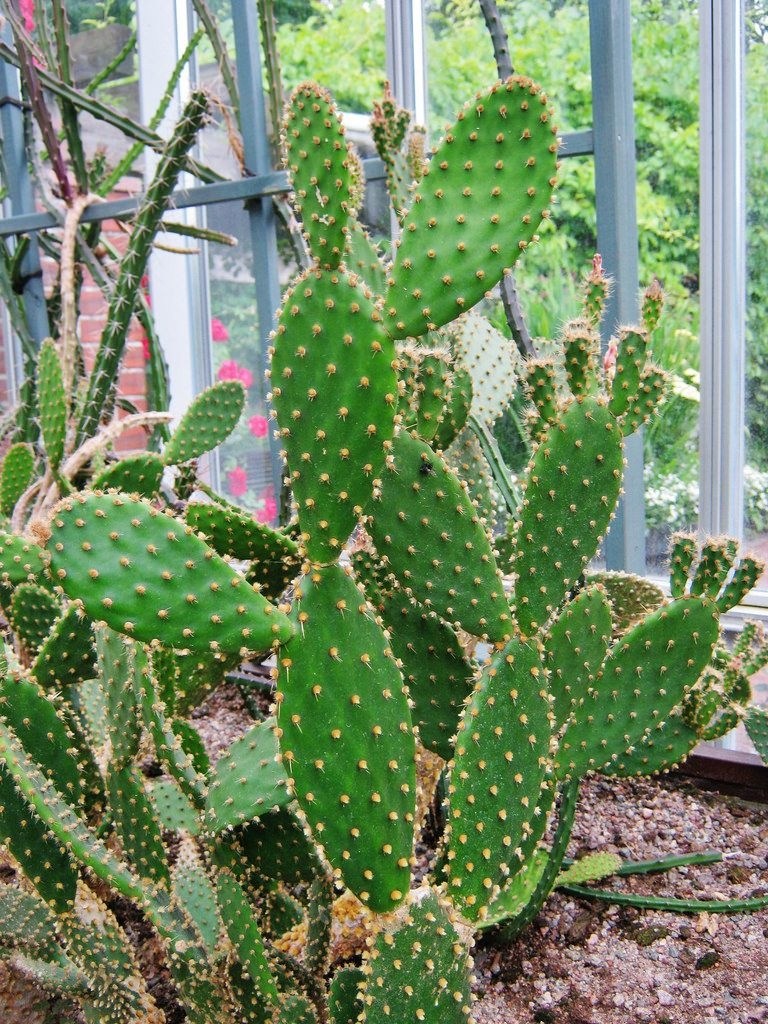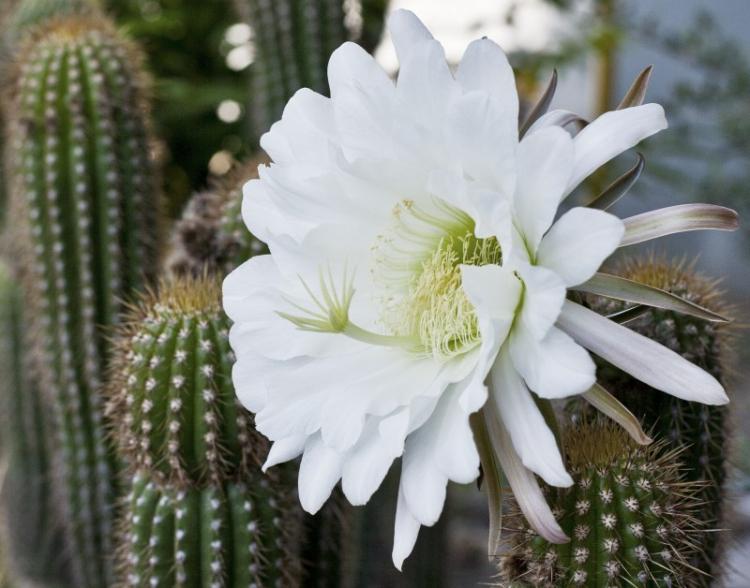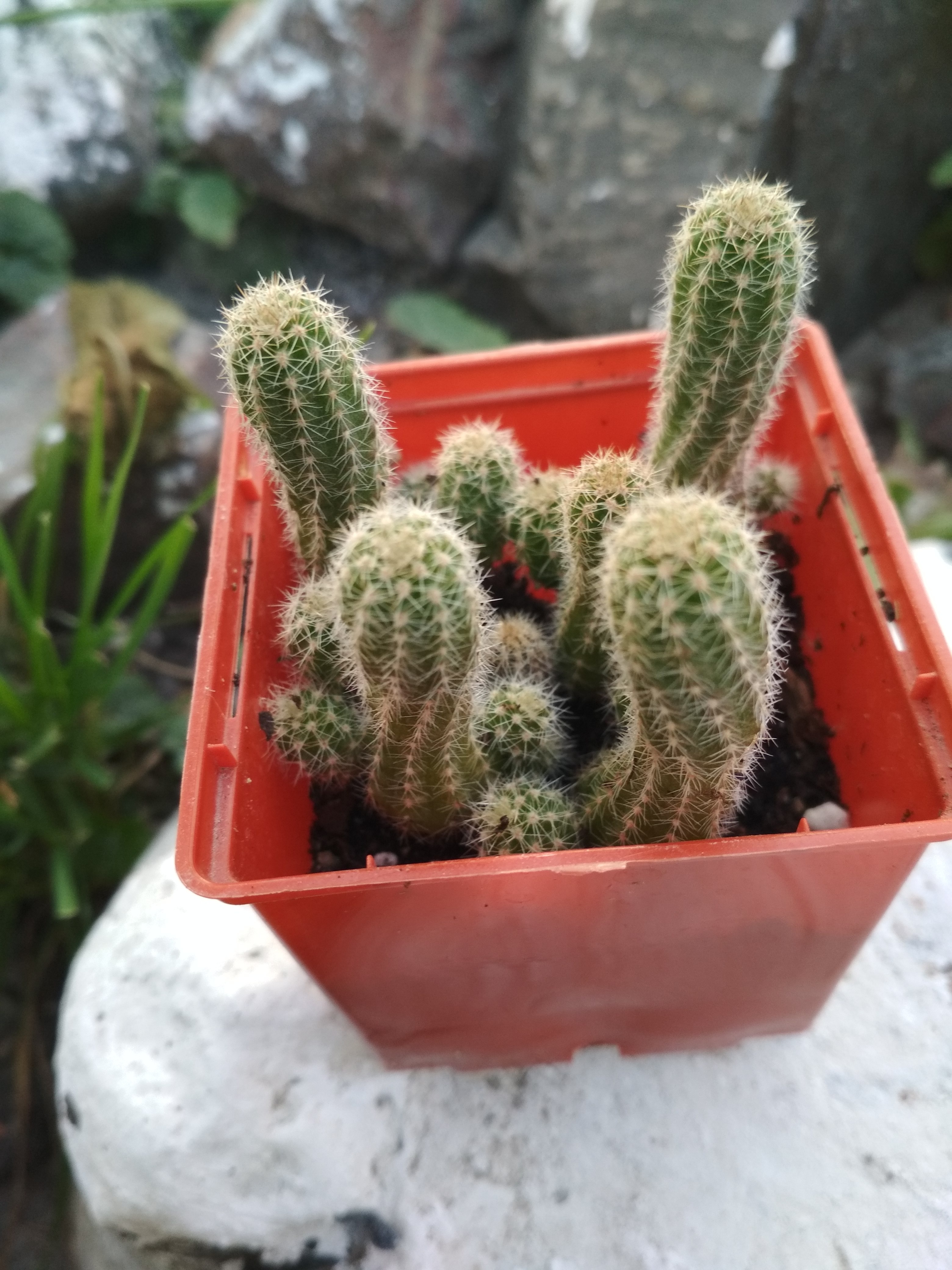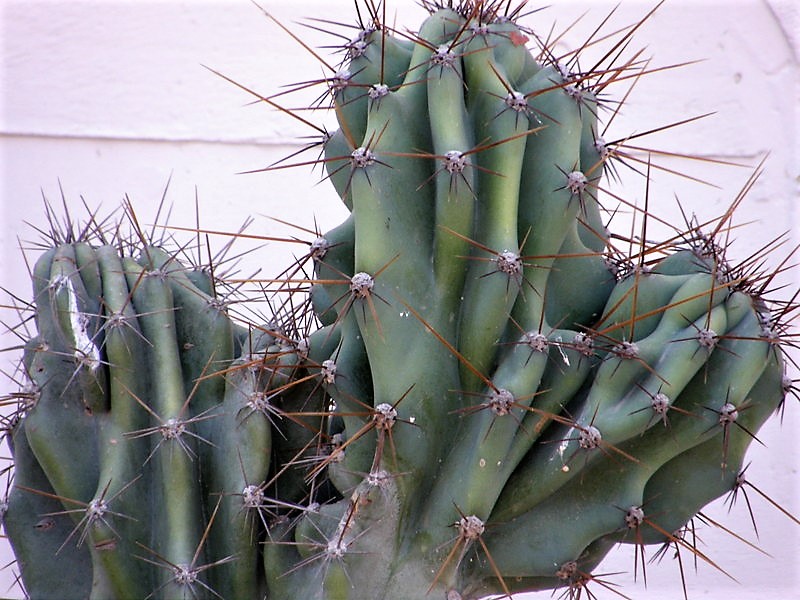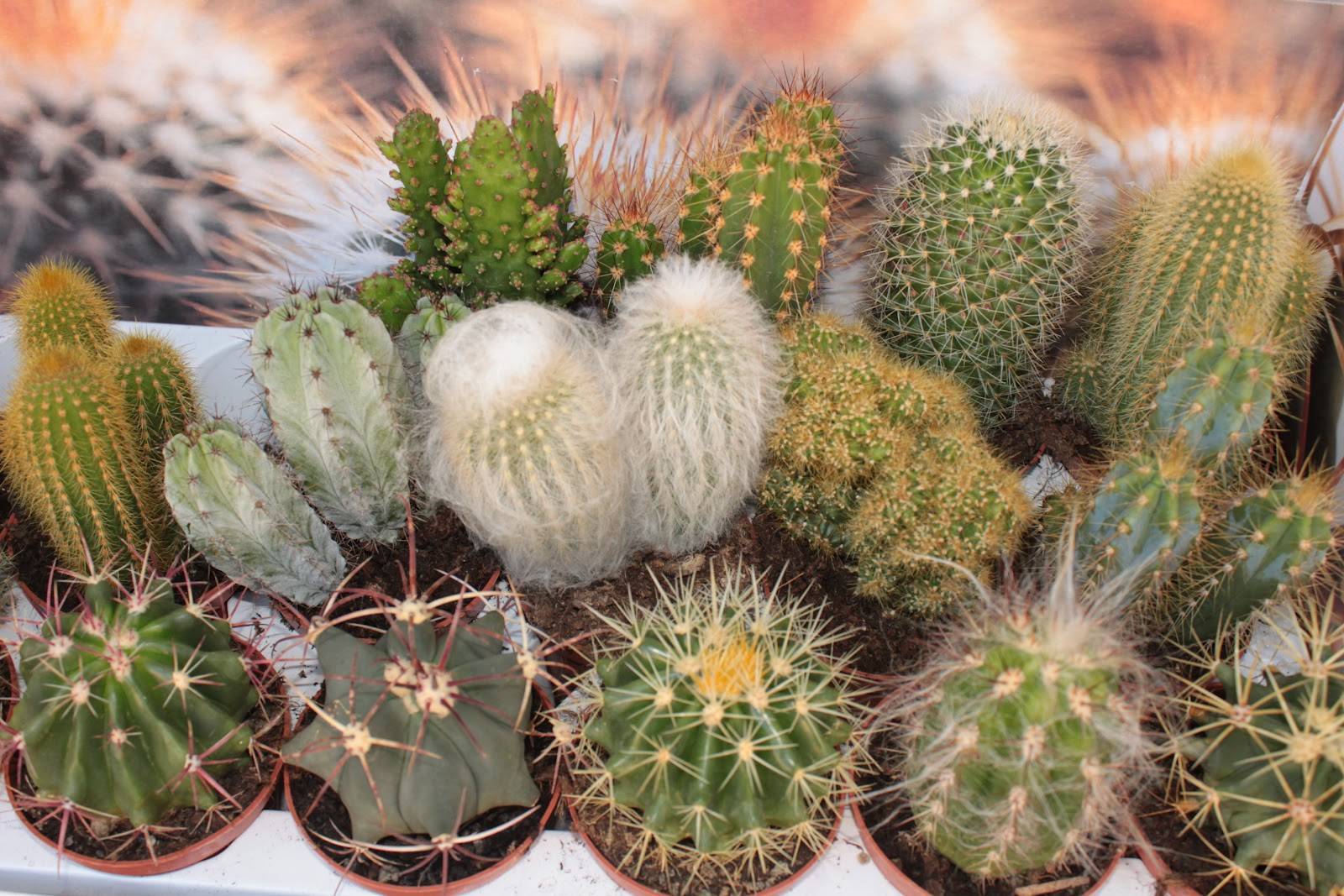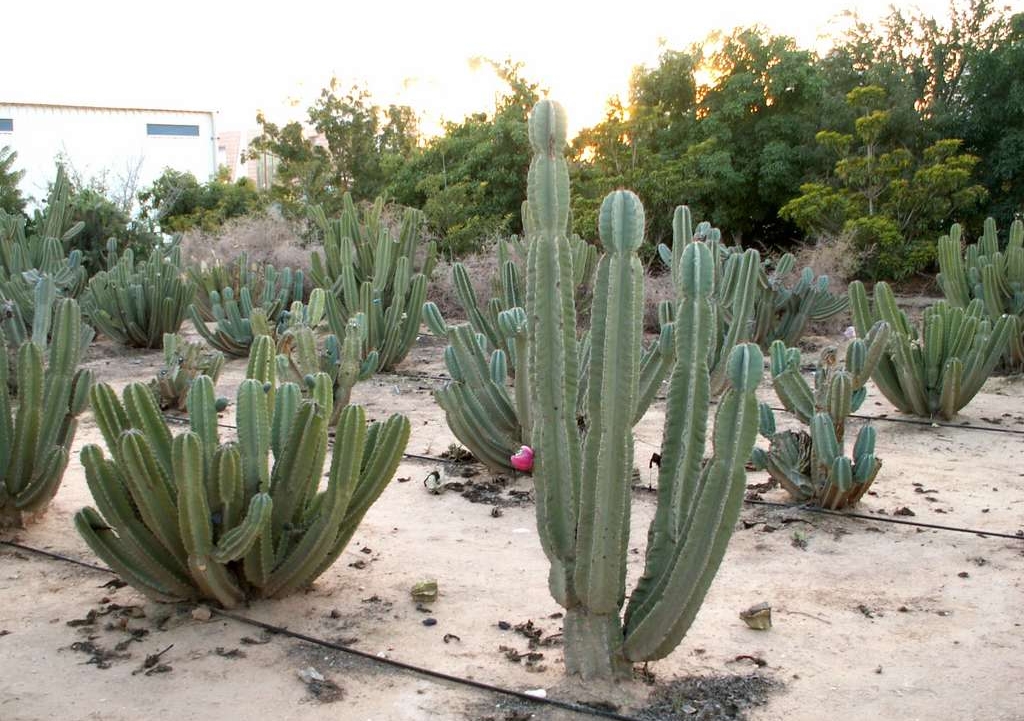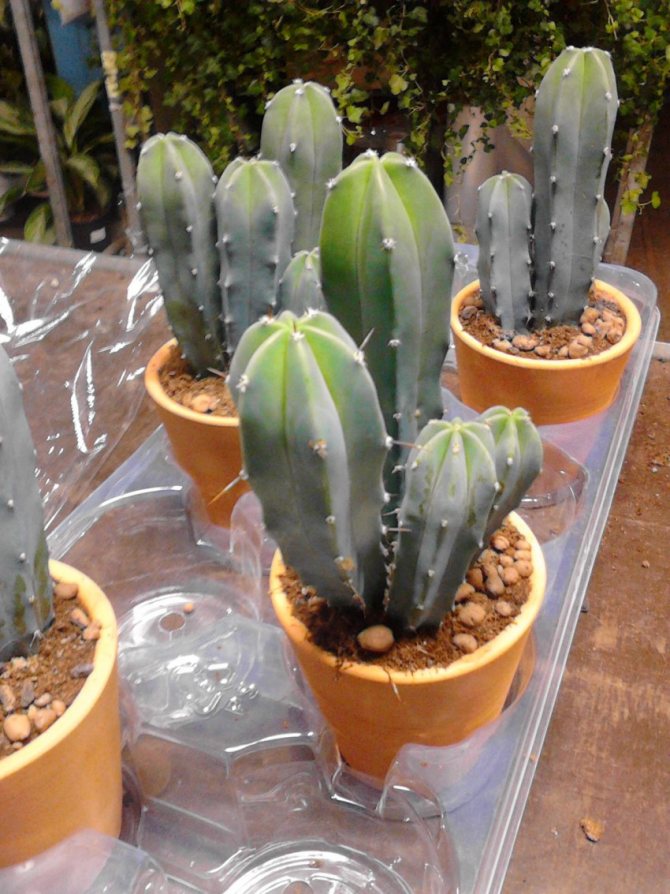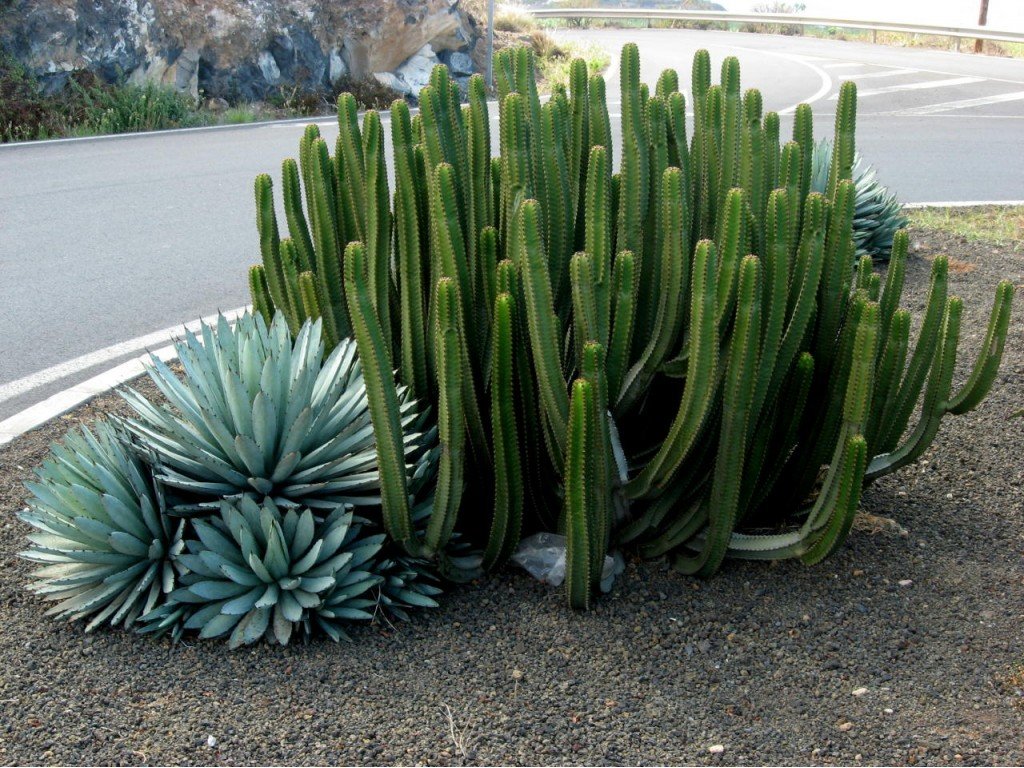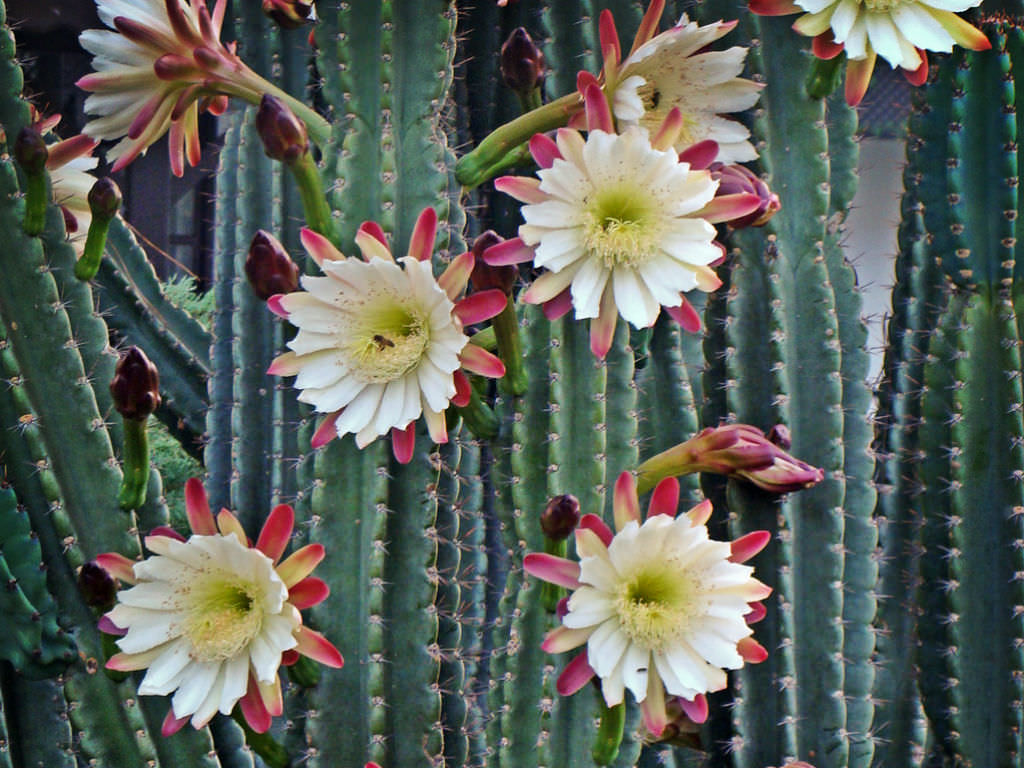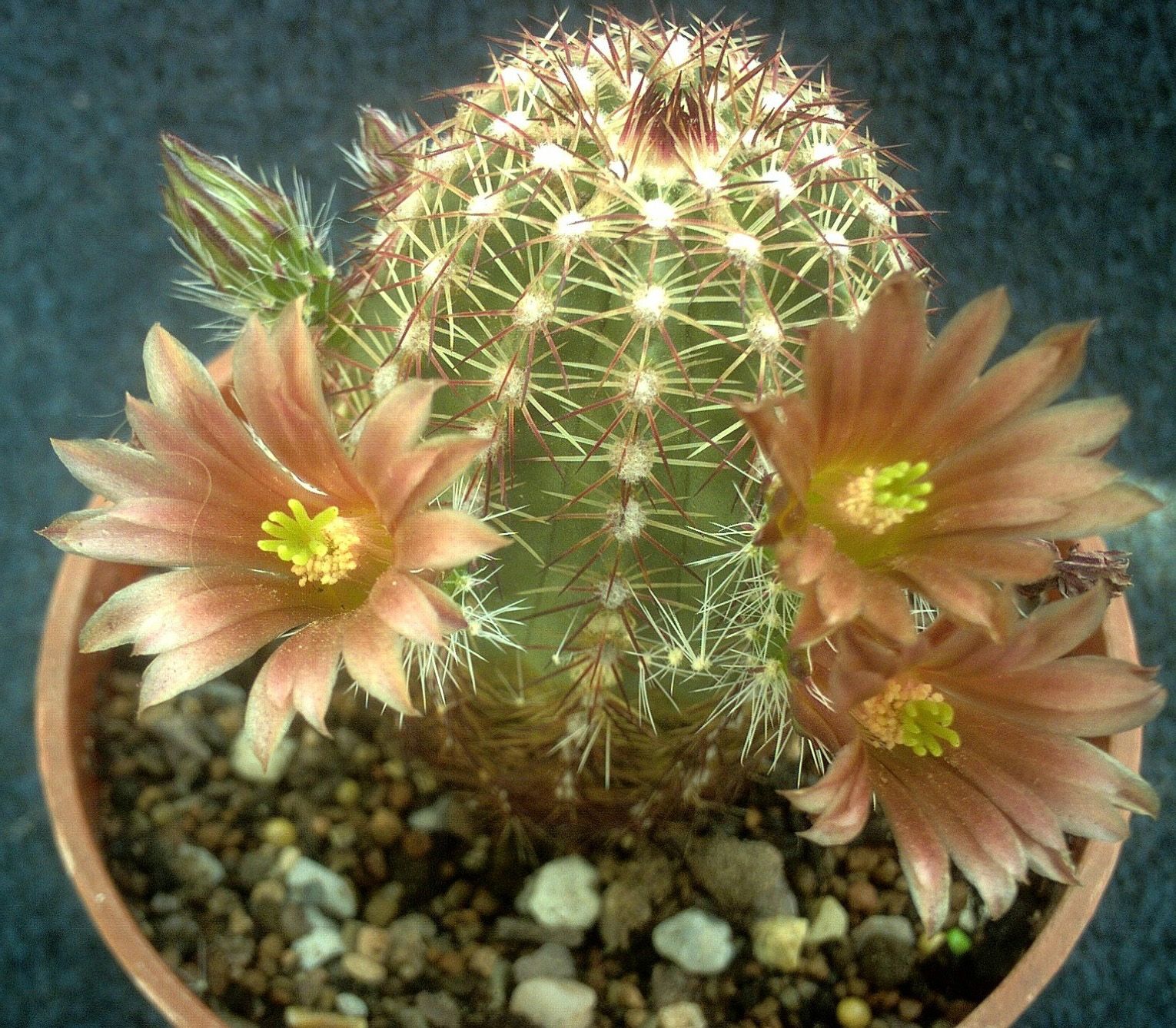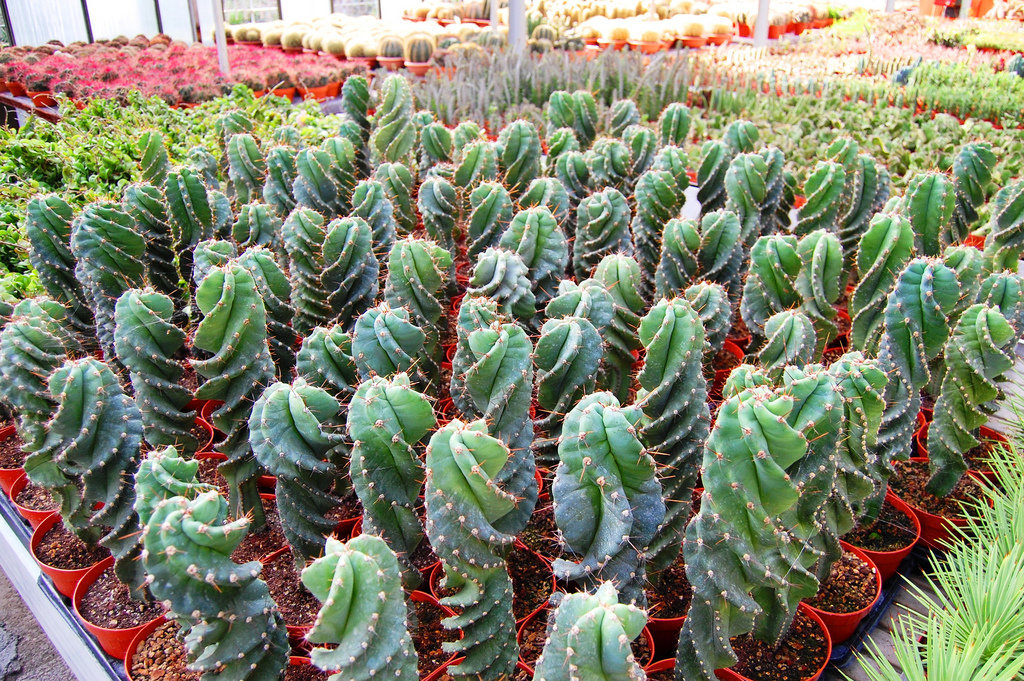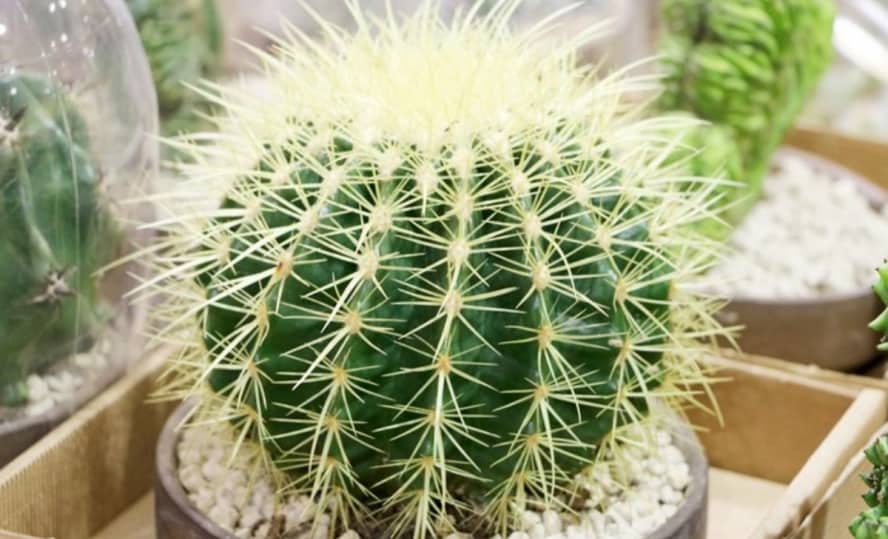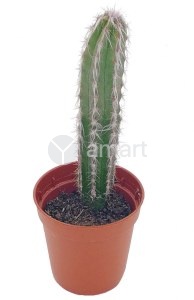Cereus care at home
These cacti are considered unpretentious. For them, you do not need to select a special soil composition, carefully monitor the temperature and lighting.
Due to their hardiness, Cereus is often used as a rootstock for more delicate and capricious species of cacti. With the help of vaccinations, breeders have bred many new, extremely beautiful and decorative varieties of cacti.
Lighting
Cereus like good, bright lighting all year round. If you have a choice, it is better to place these plants on the south and southeast side of the house.
Although Cereus is very fond of direct sunlight, there is a danger of burns in the spring and summer. To preserve cacti, you need to gradually accustom them to the sun after winter.
Temperature
The optimum temperature in winter is from 8 to 12 degrees. In warm weather, Cereus tolerate heat and daily temperature drops well. In summer and early autumn, you can keep these cacti on your balcony or open veranda.
Watering
Water for irrigation should not be cold or too hard. In spring and summer watering is moderate, in autumn watering is gradually reduced, and in winter it is practically stopped. Excess moisture is harmful to these plants, they quickly begin to look weak and get sick.
In the warm season, it is useful to spray the cereus with clean warm water.
Top dressing
Cereus grow intensively and therefore need additional feeding. The best time for this is from mid-spring to mid-summer. You can use liquid fertilizers, you can simply sprinkle with water enriched with microelements.
If the cactus has just been transplanted, feeding is not required for at least two to three weeks: the fresh soil has enough nutrients.
The soil
The soil should be neutral or acidic, but not alkaline. Sand and brick chips should be included in the potting mix.
Rich soils with a lot of humus are not suitable for Cereus.
Dormant period
The wintering place should be light and warm. It is not recommended to rotate the plant in relation to sunlight.
In winter, cacti are not fed and are very rarely watered.
Transfer
Depending on the growth rate of cacti, they can be replanted annually, or once every two years. The pot should be wide and deep enough.
Reproduction
In nature, Cereus reproduce by seeds. Occasionally, parts broken off from the stem can take root, this is an analogue of propagation by cuttings. At home, rocky forms of cacti are propagated only vegetatively - by cuttings.
Cuttings are obtained from cut shoots dried for several days. It is best to separate them in the spring, in the first half of summer. The prepared cuttings are planted in a shallow pot with suitable soil and slightly moistened. After 2-4 weeks, the cuttings are taken. Then young cacti can be planted and watered as usual.
Seed propagation at home begins in the second half of spring. The soil in the seed pot should be constantly moist, but not excessively. Until the emergence of shoots, the pot can be kept in the shade, then rearranged in a lighted place, but not in direct sunlight. The best temperature is from +18 to +20 ° С.
Young cacti will have thorns after 3-4 weeks. At this time or a little later, they can be seated.
Diseases and pests
Cephalocereus are quite resistant to various diseases and insect pests. However, inappropriate conditions for cacti can contribute to the development of mealy worms and flat red mites.
Therefore, the "hair" of the plant must be periodically checked for the presence of unwanted inhabitants in it.
Also, with the outside air, a spider mite can get on the cactus.
To prevent its appearance, it is necessary to spray cacti with any remedy for ticks twice a year - in spring and autumn.
Be especially careful if you take the Cephalocereus outside or near an open window.
Pests and diseases
Pests and diseases for Hageocereus are not terrible if all measures and conditions for plant care are followed. But regular violation of the terms and conditions can easily trigger the onset of symptoms of noncommunicable diseases. A common problem with Hageocereus is root rot, which occurs when irrigation conditions are regularly violated and are provoked by bacteria.
Advance care and attention can protect a cactus from this trouble. In the presence of rot, the plant must be treated with drugs of chemical or biological origin and transplanted into new soil
But every gardener should remember that the fight against rot is less effective than the desire to prevent its occurrence.
And for those who like to know more, we suggest that you familiarize yourself with the video about Hageocereus
Diseases and pests
Cactus "Cereus" often becomes a "target" for various insects. Most often it is a scale insect that consumes plant sap, a spider mite, the appearance of which is symbolized by whitish spots with villi. We must not forget about the mealybug, as a result of the invasion of which red dots and even cobwebs appear on the leaves, which after a while are supplemented with icteric spots. Destruction of any type of pest is possible with the use of insecticides.
The cactus "Cereus" often gets rotten. The appearance of this disease can be determined by the soft brown spots located on the shoots. In this case, the rot will have to first be cut off with a knife and then treated with the wound. Since putrefactive manifestations most often occur with improper irrigation, it will be enough to temporarily reduce watering, and then adjust the system.
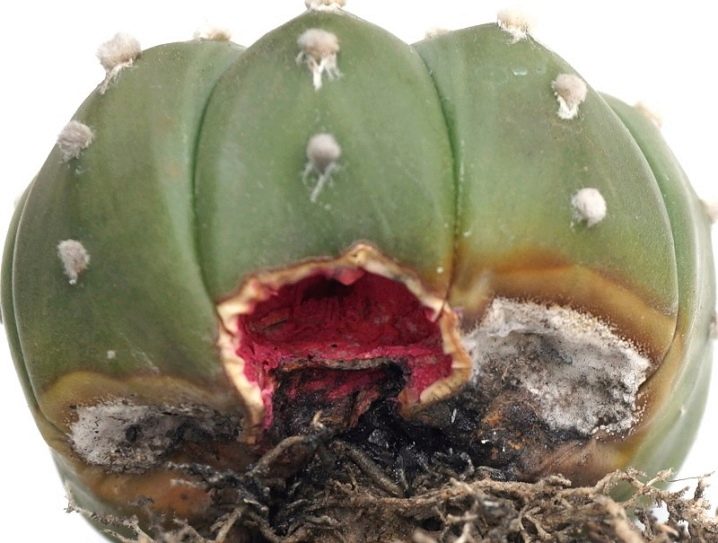
How to transplant the Cereus cactus, see the video below.
2.Hamecereus home care
2.1 Temperature conditions
In spring and summer, they are kept at a temperature of 18 - 25 ° C. For abundant flowering in the winter months, the plants are immersed in a cool dormant period, which should take place at a temperature of 8 - 10 ° C.
2.2 Lighting
Plants are photophilous and will enjoy direct sunlight in the morning and evening hours. Shade the cacti a bit on hot summer days. In autumn and winter, it is worth providing the most illuminated place.
Hamecereus is hardy and forgives some mistakes of novice florists.
2.5 Top dressing
During the period of active growth, feed with water-soluble fertilizer for cacti and succulent plants at half the concentration, monthly. During the rest period, feeding is not carried out.
2.6 Purpose
Small, willingly blooming indoor plants for well-lit areas. Lying stem chamecereus look great in a hanging basket.
Late spring - early summer.
2.8 Air humidity
Does not need spraying. During the fall / winter season, keep the cactus in a dry atmosphere and allow sufficient air movement without cold drafts.
2.9 Soil moisture
Water abundantly, completely wetting the soil with moisture, dry the top layer of the substrate to a depth of 2 - 3 cm before each subsequent watering. During the fall, the frequency of watering is gradually reduced and during the winter months the plants should be kept in practically dry soil. The need for watering at this time will be indicated by slightly shriveled stems.
2.10 Transfer
Since this cactus has a shallow root system, you can pick up wide bowls for planting. The transplant is carried out in the spring, annually
Transplanted plants are watered with care
2.11 Reproduction
Chamecereus stem cuttings root easily even by novice cactus growers in wet sand in spring and summer. Place the cut of the cuttings before planting dried for several days. Seeds.
2.12 Pests and diseases
Like most cacti, it rots easily with excess moisture, especially during dormancy. When grown in partial shade, the plants become elongated and unsightly.
Sometimes red putin mites, mealybugs, thrips and aphids appear.
Insects are pests
| Insect name | Signs of infection | Control measures |
| Mealybug or felt insect | The surface of the leaves and shoots is covered with fluffy, cotton-like white bloom. Plants are lagging behind | Folk remedies: spraying with soap and alcohol solution. Infusion of tobacco, garlic, cyclamen tubers, alcohol treatments, pharmaceutical tincture of calendula proved to be good. Chemicals: green soap solution, Actellik, Fitoverm. |
| Spider mite | Subtle spider webs on the leaves, yellowing and foliage falling off with extensive lesions. The surface of the sheet plates becomes dead and covered with small cracks. Plant development slows down. | Folk ways. Plants can be rinsed in the shower and left in the bathroom in a humid atmosphere for half an hour. Irradiation with an ultraviolet lamp every week for 2 minutes. Chemical preparations based on pyrethrum, sulfur powders, Fitoverm, Actellik. |
| Aphid | Sticky droplets appear on the leaf plates, the leaf plates curl and deform, delicate buds and young leaves wither. Insect colonies can be seen on the tops of the shoots, buds or the underside of the leaf plates. The flowers of aphid-infested plants may become deformed. | Folk methods: infusion of nettle, decoction of rhubarb leaves, wormwood, soap solution, infusion of tobacco and dandelion, onions, marigolds, yarrow, tansy, dusting with wood ash. Chemical preparations: Sulfur powders, green mass treatment with green potash soap without getting into the ground, Decis, Aktellik, Fitoverm. |
| Thrips | The appearance of yellow spots on the leaf blades, small brown dots can be observed on the underside of the leaves. When spread, the pests cause the leaves to turn yellow, dry and fall off. | Folk ways. Increase the humidity of the air, wipe the surface of the leaves with soapy water to reduce the number of pests. Preparations based on pyrethrum - 2-fold treatment with an interval of 7 - 10 days, spraying with tobacco infusion, infusion of yarrow or Persian chamomile, decoction of cyclamen tubers. Chemical preparations: dusting with sulfur powders, the use of anabazine - sulfate in a soapy solution. |
-
Mealybug or felt insect
-
Spider mite
-
Aphid
-
Thrips
2.13 Note
Young shoots can easily break off from the main plant during transplantation.
Hydroponics.
You may also be interested in:
Echinopsis
Cylindropuntium
Rebutia
Epiphyllum
Pest and disease control
It is recommended to periodically carry out preventive treatment with fungicides and insecticides. The first signs of disease or pest infestation often appear at the bottom of the stem or folds.
| Mealybug | Formation of white patches. The surface of the spots looks fluffy. | The plant and the soil around it are repeatedly treated with insecticides. Transplantation into fresh sterile soil is recommended. |
| Spider mite | Detect by small red spots and a thin cobweb. In the later stages of the lesion, yellowish dead spots are formed. | Spraying with insecticides "Aktara", "Aktellik". |
| Shields and false shields | Small insects with a convex "shell". They suck out the juice from the plant, leading to its death. | As in previous cases, insecticide treatment is carried out. |
| Rot | Fungus. It is characterized by the appearance of softened brown spots on the stem. | With minor damage, the decayed areas are cut out with a sharp knife, treated with alcohol, and sprinkled with coal powder. They are transplanted into new soil. Watering is limited. |
Cereus are often included in short plant compositions. They also look good as an independent plant in floor pots.
Botanical description of the genus Cereus
The genus of cacti Cereus (Cereus) is a unique plant from the Cactus family, reaching up to the height of a person. If you translate the name, then literally you can get "wax candle". Due to its unusual decorative appearance, the plant is actively used to decorate rooms.
The homeland of this unusual flower is the territory of South, Central America, as well as Western India. The main feature of the plant is an oblong stem, which is shaped like a cylinder. In their native lands, cacti grow up to 30 meters in height.
 Under natural conditions, some species of Cereus can reach gigantic proportions.
Under natural conditions, some species of Cereus can reach gigantic proportions.
The trunks of the common Cereus are well developed. The crown is created from shoots that do not have leaves. The stems are distinguished by large ribs of a bluish-green hue. Some species do not have ribs, instead they have papillae arranged in a spiral. There are thorns on the flowers, they are usually black, brown, gray.
At night, amazing flowers with greenish-white, pink or white color open, there is also abundant pubescence. It is thanks to this property that the name "night Cereus" stuck to the cactus. When flowering is over, fruits appear on the bush. They are represented by berries in a yellow, red hue. The fruits reach a diameter of up to 0.1 meters. Inside contains a large number of large seeds.
How to properly care for Echinopsis cacti at home
Echinopsis flower does not need complicated care. Minimal efforts on the part of the grower will allow you to get abundant flowering of the bush, as well as the unreal beauty of green thorns.
The plant should be placed on a windowsill where there is a lot of sunlight. It is best to orient yourself towards the south side. In summer, the bush is placed on the street, on an open terrace or loggia. But do not touch a plant that is actively forming a green mass. This will only harm the flower.
During the active development of the bush, it is recommended to keep it under warm climatic conditions.
It is important that the room is at least + 20 ° C. Starting from October, temperature indicators decrease to + 9-10 ° С
But sunshine should always be enough. It is imperative that the bush does not suffer from through winds. But at the same time, be sure to ventilate the room where the flowerpot grows.
Photo of one of the Echinopsis species in the greenhouse
Echinopsis is irrigated regularly, from early spring to autumn. But it is recommended to perform this procedure only after the soil is completely dry. To regulate this moment, it is better to use a wooden stick, which is stuck into the container. The moisture content of the composition is determined by the amount of adhered soil.
For watering a cactus, it is recommended to use filtered or settled water at room temperature. In the fall, they begin to moisten the bush much less, the amount of liquid used is reduced. Spraying the plant is contraindicated, since the Echinopsis cactus feels great under normal room conditions. But for hygiene purposes, it is still recommended to wash the bush under shower water, while covering the substrate with cling film.
To see the blooming Echinopsis cacti, you should provide them with full-fledged fertilizer. It is recommended to start this process immediately after the start of the active development of culture. For such purposes, complex mineral dressings are used, suitable for succulents. Substances are applied once a month. Concentration is written on the packaging. In the dormant stage, the bush does not need to be fertilized, these procedures are resumed only with the arrival of spring.
Echinopsis cactus: diseases and pests
The plant is quite resistant to diseases. But, if it is wrong to water the bush, then stagnation of the liquid will occur, which will provoke rotting of the cactus. In this case, you will need to remove all damaged areas by treating the knife with alcohol. Further, the cut sites are disinfected with a fungicide.
A common pest of bushes is the spider mite. It damages the stem, sucks sap from plants. To combat the parasite, Actellik or Fitoverm is used. Spraying is best done outdoors, since the products are quite toxic.
How to transplant a cactus Echinopsis
Adult bushes do not need to be repotted often, this procedure applies only to young specimens. When you observe that the plant is getting cramped in the pot, you should choose a larger container for it.
Young representatives of the flora are planted in a soil mixture with a neutral reaction. If you wish, you can buy a ready-made substrate in the store. But often the composition is prepared by hand. This will require coarse sand, leafy, soddy soil, small gravel. The proportion is 2: 2: 4: 1. A little charcoal is also added to the mixture. With its help, it will be possible to reliably protect the rhizome from the development of rot.
It is recommended not to transplant adult bushes at all, but simply to replace the top layer of the soil with a fresh composition.
Pots are usually low, but wide enough for plants. At the bottom of the container, you will need to place a drainage layer; it is best to use expanded clay for such purposes. It is better to move the bush by the transshipment method so that there is a certain amount of soil on it. Formed voids must be filled with prepared soil mixture, thoroughly rammed. Immediately after transplanting, you will need to water the bush abundantly.
Reproduction
Pilosocereus reproduce only by seeds. Growing cacti from seeds is not an easy task, but if the necessary conditions are met, it is achievable.
To begin with, cactus seeds are separately planted in prepared peat tablets. Then they create conditions for germination by placing them in a mini-greenhouse with temperature and humidity values of +25 ° C and 55%, respectively.
After a few weeks, the formation of small pilosocereus can be observed on the soil surface.
After another 6-8 weeks in this mode of keeping, small cacti will become slightly larger. At this time, you can try to transplant young pilosocereus in a larger container and adapt them to a new habitat. In the coming month, cacti are protected from direct sunlight.
All types of mammillaria: names, descriptions and photos during the flowering period


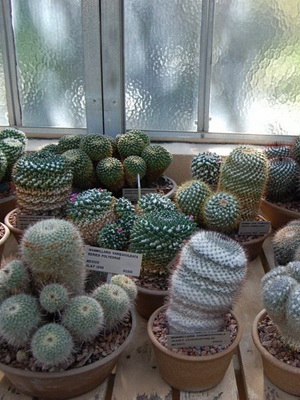

The photo shows that not all types of mammillaria cactus have the same structure - their number exceeds 180 varieties, each of which has its own characteristics and is very beautiful during the flowering period. Below is a description of some of them.
Popular types include:
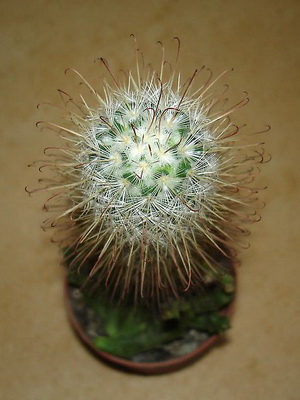
Mammillaria satin (M. bobycina);

Mammillaria blond (M. albicoma);

Mammillaria to the Hague (M. haagea);
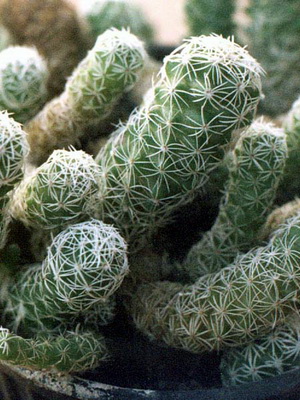
Mammillaria graceful (M. gracilis);
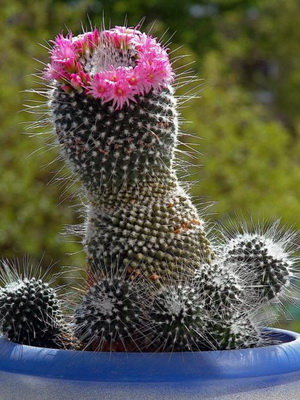
Mammillaria beautiful (M. formosa);
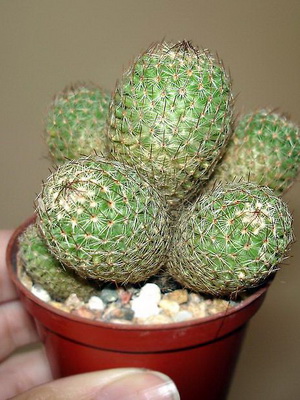
Mammillaria Matudae (M. matudae);
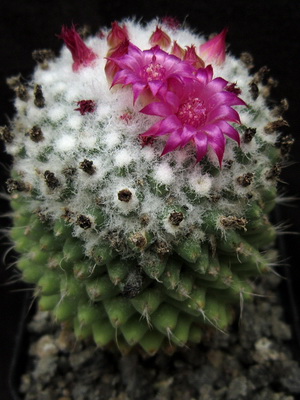
Mammillaria beautiful (M. perbella);

Mammillaria snow-headed (M. chionocephala).
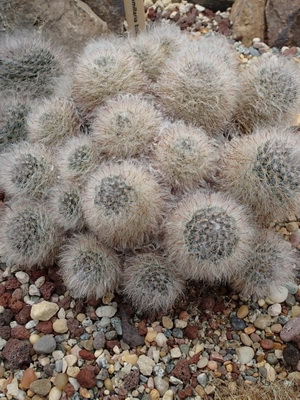

Mammillaria bocasana (Mammillaria bocasana). As you can see in the photo, this type of mammillaria cactus has a very peculiar smoky surface, which is why it is appreciated by many flower growers. This is a small plant that forms a group shrub with different sized balls. The entire outer part of the flower is densely covered with a felt-hairy pile, the length of which reaches 2.5 cm. In the center of each fluff formation there is one large brown spine. In most, the species is valued by flower growers only because of this feature, since this mammillaria blooms with completely nondescript pink flowers.


Mammillaria carmenae (Mammillaria carmenae).At a young age, the plant is solitary and has the shape of a round ball, but over time it stretches and becomes like a cylinder. Already mature cacti give many young shoots, which is why a lush bush is formed, the width of which can reach 16 cm. The height of the plant does not exceed 9 cm. The areoles of this flower are covered with a large amount of fluff and thorns. The flowers can be cream or pale pink in color and are small in size.
Among all other species, this mammillaria is valued due to its high resistance to low temperature conditions, which is quite important for growing in temperate latitudes.


Mammillaria beautiful (M. perbella). The plant has the shape of a slightly elongated ball, the height of which reaches no more than 6 cm. A small number of small spines are also located on the weakly pubescent areoles. The flowers are pink with small splashes of white.
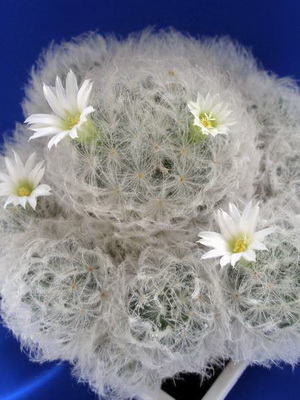
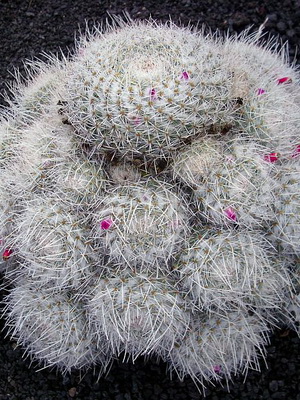
Mammillaria blond (M. albicoma). As you can see from the photo, this type of mammillaria got its name due to the strongly pronounced hairiness, which forms a white veil on the entire surface of the cactus. It is very small and spherical. The flowers are white or cream in color with a large number of stamens in the center.
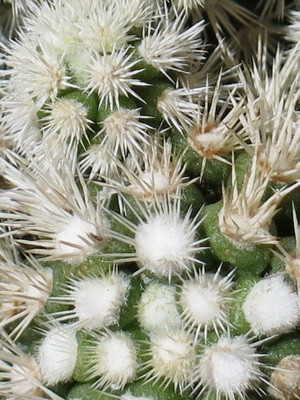
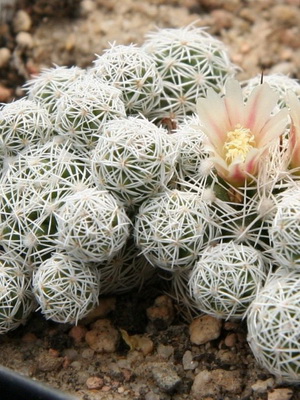
Mammillaria graceful (M. gracilis). This cactus is one of the most popular types of mammillaria, which, in comparison with its counterparts, has a rather large growth - 12 cm.The diameter of the cylindrical trunk is 5 cm.This species also has a well-developed hairiness, which makes it seem from afar as if the plant is braided with cobwebs ... A distinctive feature of this cactus is a very large number of shoots, as well as flowering in the winter season. Its flowers are tubular, elongated, yellow-cream in color.
Lobivia care at home
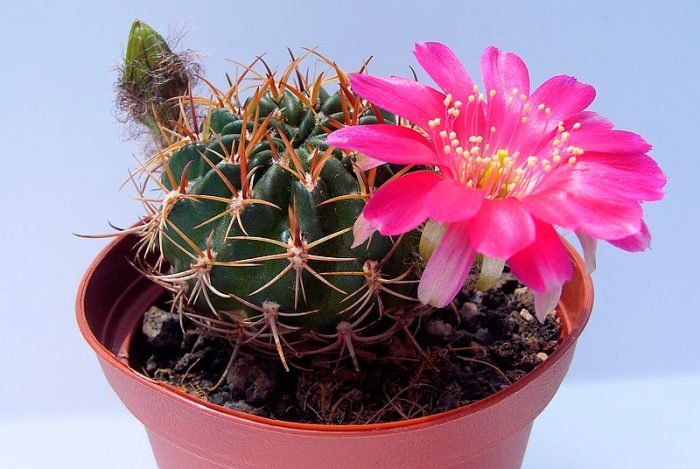
Practically, like all cacti, this plant is undemanding to care for and not capricious. However, in order for it to grow and develop normally at home, you should know and follow several rules related to care.
Illumination
This plant is very demanding on lighting. So, for successful flowering, a cactus needs bright sunlight in large quantities. It is recommended to place it near a south-facing window. In the event that it is not possible to place lobivia on the southern window, then it will need to be provided with supplementary lighting using phytolamps. Thus, experts in the cultivation of cacti advise the use of high-intensity lamps intended for greenhouses with a power of 100 watts. At the same time, 1 light bulb is enough to illuminate 0.1 m2.
Temperature regime
You feel normal at a temperature typical for central Russia. However, you should know that this plant needs sharp changes in day and night temperatures. In this regard, it is recommended to move it to the street, where it should be from mid-spring to mid-autumn. A place should be chosen well protected from precipitation.
In winter, the cactus has a dormant period. At this time, the recommended temperature for him is 8-10 degrees. The intensity of flowering depends on the cold wintering.
How to water
During intensive growth, lobivia is watered very carefully. So, it will be necessary to moisten the earth abundantly only after the soil in the pot dries well. Overflow is unacceptable, because it can provoke stem rot and death of the plant. In the middle of summer, the plants should not be watered for 4 weeks, and then normal watering must be resumed. However, in the fall, each time it is watered less and less. In November, they stop watering the cactus again. The "dry" period lasts until spring, watering is resumed only after the formation of flower buds. It is necessary to strictly follow this watering regime, otherwise the plant will drop the buds.
Earth mixture
Suitable soil should be neutral, loose, air and water permeable.For planting, you can purchase a special earthen mixture for cacti, only you need to add a little fine gravel, as well as coarse sand, to it.
For planting, you should choose a wide and fairly low pot, since the roots of the plant are superficial, and also because it gives many basal processes.
Transplant features
It is recommended to transplant the plant in spring and only after the overgrown cactus becomes cramped in the old pot.
Echinopsis cactus, people's favorite! Cactus transplant lesson. Echinopsis genus.
Fertilizer
It is necessary to feed during intensive growth (March-September) 2 times a month. For this, special fertilizers for cacti are used. During the dormant period (October-February), it is prohibited to apply fertilizers to the soil.
Reproduction methods
Can be propagated by seeds and roots.
For vegetative propagation, the lateral shoot must be carefully separated from the parent plant. Then it must be left in the air to dry.
After 24 hours, it is planted in a soil mixture, to which more sand should be added. When the cactus is rooted, it is transplanted into a permanent pot.
For propagation by seeds, you must follow the instructions in the instructions on the package.
Pests and diseases
Often, aphids, scale insects, spider mites or mealybugs settle on the plant. If pests are found, treat the plant with a special insecticide.
Root rot may appear due to overflow.
Exotics in the apartment and office
Lobivia are low-growing cacti. Their miniature forms start from 2 cm in height. So, in Lobivia Arachnakant, the stem does not exceed 4 cm in diameter. It is small-tuberous, covered with thin spider-like spines, grayish-green, unattractive. The apotheosis of beauty falls on the flowering period. Huge bright flowers completely hide the unattractive stem.
The overgrown dense pillows of Sylvester Lobivia are magnificent in miniature cactus gardens. Abundantly flowering plants attract with their unusually large flowers. Please note! Sylvester's lobivia blooms profusely only after a cold winter.
Separate bright spots of large flowers of bright crimson, bright pink, red golden yellow flowers stand out in the offices of Lobivia Chrysant, Crucible, Bakeberg, Schreiter, Golden yellow and others.
Among the wonderful solitary exotics, one cannot fail to note. An attractive plant with a stem 5-6 cm thick, bluish-gray-green in color. The ribs of the stem are decorated with 10-20 spiny areoles of brown color up to 5 cm in length. It blooms with red funnel-shaped flowers 6-8 cm in diameter.
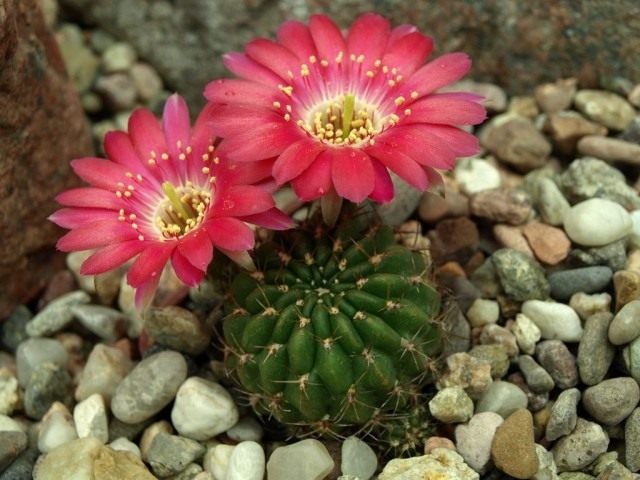 Echinopsis Bakeberg or Lobivia Bakeberg (lat.Echinopsis backebergii). lobivia
Echinopsis Bakeberg or Lobivia Bakeberg (lat.Echinopsis backebergii). lobivia


